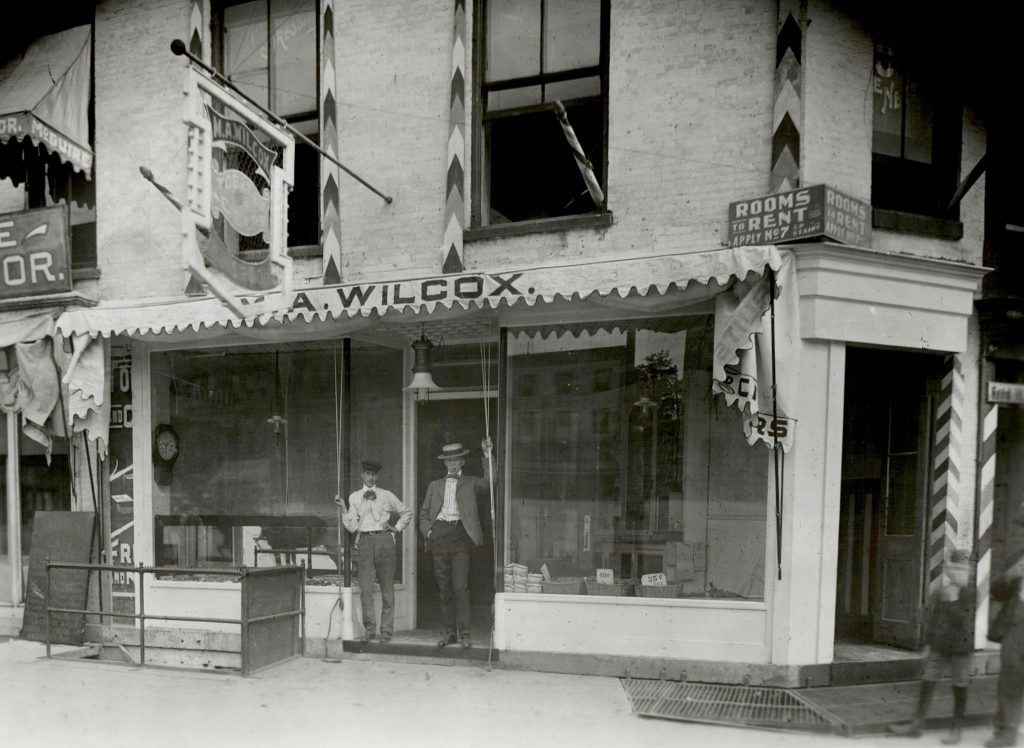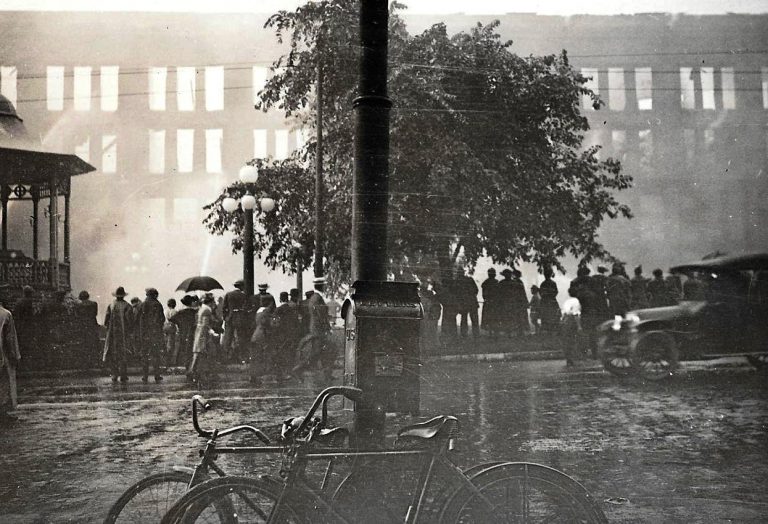Streeter Block Become J B Wise Block, Home to the Victoria Theater
The Streeter Block was built in 1843 by Nelson W. Streeter, a clothier and clothing manufacturer. Throughout its history, the four-story block building would be host to numerous stores ranging from the aforementioned clothing to grocers, meat markets, liquor stores, restaurants, and tobacco shops on the street level with apartments on the upper three floors.

According to Through Eleven Decades of History: Watertown, by Joel H. Monroe, the Streeter Block was also home to a school early on–
Mrs. Charlotte Hunt’s school for young ladies, from about 1838 to 1849, commanded much attention and had patronage of the best of the families in the village. Mrs. Hunt was a woman of singular ability, and beautiful in both personality and character. The school was quartered in the old Streeter Block on Public Square. Mrs. Hunt was the wife of Alvin Hunt at that time editor of the “Jeffersonian,” a weekly newspaper.
In the 1860s, the Streeter Block would have a few exciting advertisements at the H. Sloat Grocery Store and Brigg’s and Wilson as well. Apple cider vinegar seems to have become a popular health remedy over the last number of years, but it was sold back then, too. Long before Starbucks was whipping up a venti pumpkin spice latte with eight shots of espresso, seven pumps of pumpkin sauce, and one pump of maple pecan sauce, you could get yourself “Maple-flavored yellow coffee” at the Streeter Block as well, though most likely not via a drive-thru.

The block building would stay in the Streeter family, passing from Nelson to son, and former Watertown mayor and postmaster John C. Streeter, who also ran a clothing business there. The Ogdensburg News would make note of Nelson’s contributions in the 1912 obituary of his son, John–
One of the monuments to the business sagacity and energy of Nelson W. Streeter is found in the Streeter building, on the Public Square, which teems with the business life of the city. Being associated with the Whig party in early life, he identified himself with the Democratic party in 1856, and continued this allegiance until his life closed.
Nelson, on top of building the block and enterprise, also served as a city trustee and sheriff for Jefferson County. His son, John, would also have a distinguished career outside the clothing business as well, having been an incorporator to the Watertown Spring Company and one of the first trustees to the Watertown Savings Bank.
In April 1906, six years before his death, John Streeter sold the Streeter Block to James Black Wise, better known as J. B. Wise, and the block was renamed the J. B. Wise Block (or building, as was on its façade sometime thereafter.) Wise would also be an enterprising type, owning several businesses, as well as also having served as mayor of Watertown.

The Victoria Theater
On January 19, 1913, the Watertown Daily Times would report on the rumored construction of a theater in the Streeter Block–
Although no official announcement will be made for some time, it became known that plans are being made for the construction in the Streeter Block one of the finest moving picture and vaudeville houses in this part of the state. The plan as outlined to a Times reporter is to tear out the two stores conducted by the Black River Bakery and the Haynes Optical Co. and to erect the theater where they are now located.

The Victoria Theatre would be part of a complete remodel for the J B Wise building. Debuting to the public on August 30, 1913, it would be managed by Joseph A. Hines, who also managed the Bijoux theatre at the Smith Building, later named the Mohican Building. The Watertown Daily Times would report on the Victoria–
Fully 70 city officials and members of the press accepted the invitation of Joseph A. Hines and attended the opening of his new Victoria theatre in the Wise building at 8 Friday night. The little theatre is a miniature of the Victoria in Rochester and is the finest of its kind north of the main line of the Central, having a balcony, a tiny stage, two boxes, and attractive entrance and exists to comply with the law. It has a seating capacity of nearly 500 and the seats are comfortable and well spaced.
Other businesses located in the J B Wise Block at the time included Haynes Optical Company, Martin Duggan’s Tobacco Store, the W. H. Prichard Liquor store, George A. Crandall’s restaurant, and several other businesses.

In 1945, the J B Wise Block would be purchased by George N. Ronson and Lazarus Stamat from J. B. Wise’s widow, Hattie C. Wise. A year later, Ronson would sell his interest to Stamat, who, in 1950, would sell it to Samuel Silver of New York City. Sometime after that, Silver would sell the property to Louis Cavanaugh of Chicago, Ill.
In 1946, a fire would cause $30,000 worth of damage to the J B Wise Block, destroying the Crandall Restaurant and badly damaging two other businesses, including the Victoria Theatre, though it would re-open.
18 Families would temporarily be displaced – though the apartments themselves would later be vacated in 1953 with plans to modify the building. The Daily Times would note this when the remaining block building tenants were given notice to vacate in 1958–
Wise Block Razing Seen As Tenants Must Leave
The five remaining tenants in the J. B. Wise building, all business establishments extending from 109 Public Square to 111 Mill Street, have been ordered by the owner of the property to evacuate by April 30, presumably as a preliminary step toward reported plans to raze the 115-year-old four story site.
The only tenants in the building are on the ground floor. In July, 1953, occupants of the 19 apartments above the first floor were vacated under a plan at that time to cut the size of the building to two stories for office use only. This plan, however, never materialized and the building since has had occupants at the street level only.

The remaining businesses at this point included Savoy Restaurant, operated by James J. Stamos, which would actually remain; Haynes Optometrists, Operated by Carl J. and Fred J. Haynes; Coffee Club restaurant, owned by John Rapp; Pritchard’s Liquor Service, owned by Pardon C. Williams; and Todd Orthopedic Rebuilding company, operated by Arthur M. Todd.
In late July of 1958, the former Streeter Block/J B Wise Block building would be razed with the exception of the portion housing the Savoy Restaurant which would later become home to Mr. M-Goo’s Bar and Grill in 1968.

















1 Reviews on “Streeter Block – J B Wise Block (1843 – 1958)”
LOLOL. With MEAT MARKET in such big letters, maybe it was one of the first cheesy singles bars in the area??
LOL. The irony considering the school for young ladies was there as well.